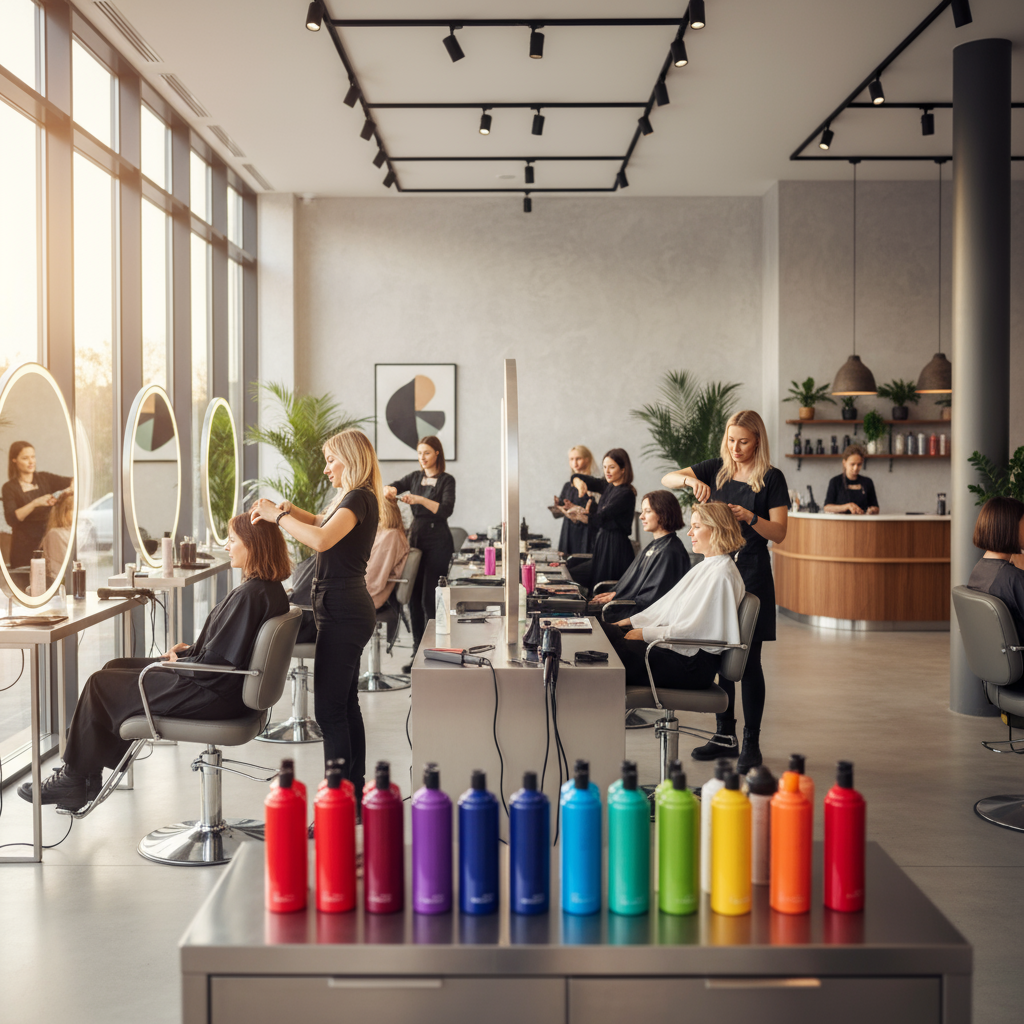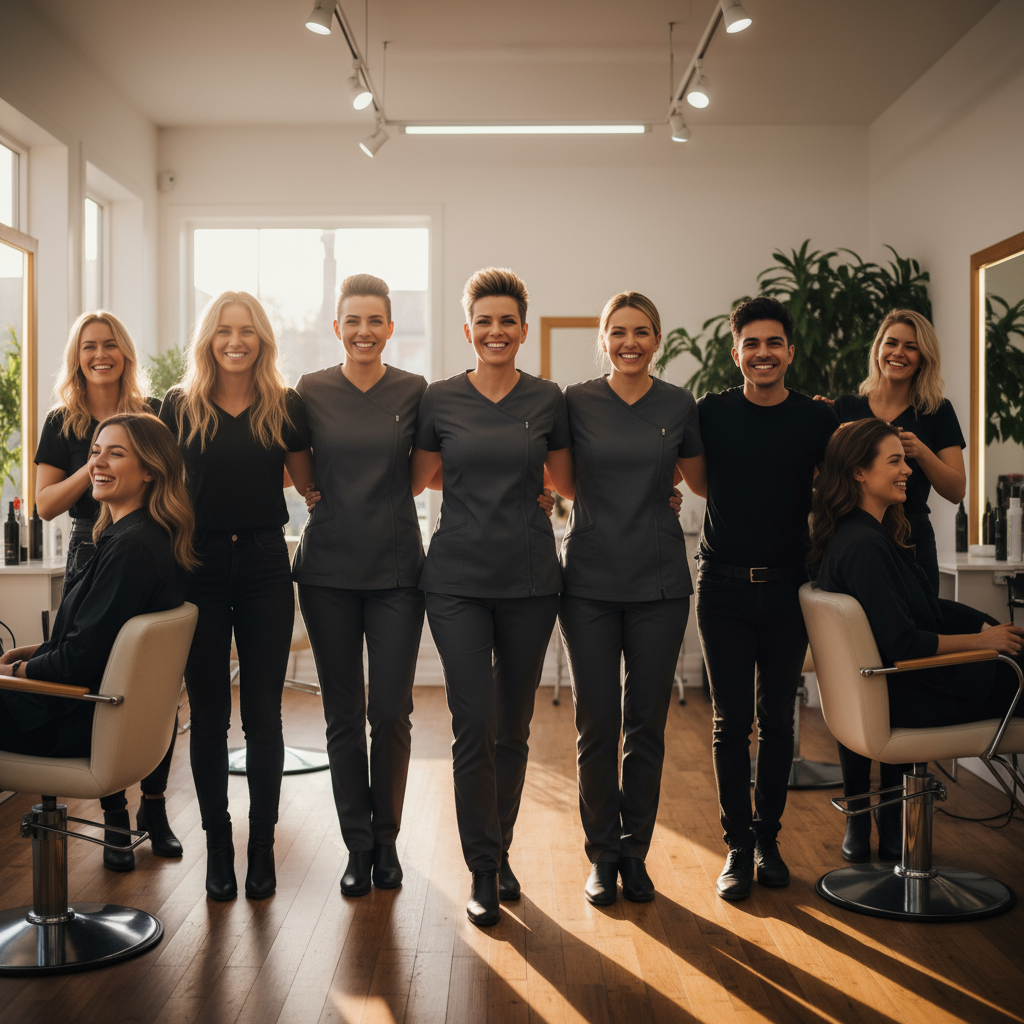
Table of Contents
Introduction
Running a hair salon is amazing—there’s nothing quite like helping clients feel their absolute best. The creativity, the connections, the satisfaction of transforming someone’s look? Pure magic. But let’s be real for a second. Behind all that glamour lurks some pretty serious business risks that could turn your dream salon into a financial nightmare faster than you can say “bad haircut lawsuit.”
Think about it: you’re working with sharp tools, chemicals, hot equipment, and people’s precious hair (which they’re surprisingly emotional about). Your salon is packed with expensive gear, and you’ve got clients walking around on potentially slippery floors. One wrong move—literally—and you could be facing a liability claim that makes your monthly rent look like pocket change. That’s where salon insurance comes in, and trust me, it’s not just another business expense you can skip.
Here’s what keeps many salon owners up at night: property damage from fires or theft, customers slipping and falling, equipment breaking down, or even claims related to the services you provide. And don’t get me started on employee-related issues that can lead to workers’ compensation headaches. The beauty industry might look glamorous from the outside, but it comes with its own unique set of risks. If you’re new to business insurance (and honestly, even if you’re not), checking out insurance basics can help you wrap your head around how these policies actually work and why they matter for your specific situation.
Now, let’s talk about the heavy hitters in salon insurance. General liability insurance is your first line of defense—it covers those slip-and-fall incidents that unfortunately happen more often than we’d like. Property insurance protects your space and all that expensive equipment you’ve invested in. Professional liability insurance? That’s your safety net for service-related claims. (Yes, even if you’re amazing at what you do, sometimes things go sideways.) Then there’s business interruption insurance, which can be a lifesaver if something forces you to close temporarily. You need to know what coverage is required by law in your area too. For the nitty-gritty details on staying compliant, diving into small business insurance requirements is time well spent.
But here’s something people don’t talk about enough: knowing how to actually use your insurance when things go wrong. The claims process can feel overwhelming when you’re already dealing with a crisis. And those deductibles? They directly impact what comes out of your pocket and what you pay in premiums. Getting familiar with resources about the insurance claims process and insurance deductibles can save you stress and money down the road. While we’re on the topic of financial planning, understanding broader money management concepts—like the principles covered in articles about budgeting or asset protection strategies—can give you a more complete picture of how insurance fits into your overall financial strategy.
What You’ll Learn in This Guide
This guide is your roadmap to salon insurance that actually makes sense. Whether you’re just opening your doors or you’ve been cutting hair for years, we’re going to break this down in a way that’s practical and actionable.
- Understanding the Risks: We’ll walk through the real risks salon owners face—from property damage and liability claims to employee issues. Once you know what you’re up against, choosing the right coverage becomes so much clearer.
- Types of Insurance Coverage: Get the lowdown on essential policies like general liability, property insurance, professional liability, and workers’ compensation, plus extras like business interruption coverage that could save your business.
- Choosing the Right Policy: Learn what factors actually matter when picking insurance—your salon size, services, staff count, location, and budget. We’ll help you find protection that works without breaking the bank.
- Preventing Common Claims: Discover the most common insurance claims salons face and get practical tips to minimize risks before they become expensive problems.
What comes next will give you the confidence to handle your salon’s insurance needs like a pro. No more confusion, no more wondering if you’re covered—just solid protection for your business and peace of mind for you.
We’re going to dig into the specific insurance policies every salon should consider, explain exactly what risks they cover, and give you a clear framework for evaluating your options. Your salon is unique—whether you’re a cozy one-chair operation or a bustling full-service spa—and your insurance should reflect that. We’ll cover how factors like your location, services, and team size should influence your insurance decisions.
You’ll also get the inside scoop on common salon insurance scenarios (think slip-and-fall accidents, allergic reactions to products, or equipment damage) and learn proven strategies to prevent them from happening in the first place. By the end of this guide, you’ll have everything you need to make smart insurance decisions and protect what you’ve worked so hard to build. And hey, while you’re building your insurance knowledge, exploring related topics like insurance deductibles and insurance for startups can help you see the bigger picture and ensure your coverage is rock-solid.

Running a hair salon without proper insurance? That’s like cutting hair blindfolded—sure, you might get lucky, but why take the risk? Your salon faces unique challenges every single day. A client could slip on a wet floor. Equipment might get stolen. Fire could damage your space. (And let’s be honest, with all those electrical tools and chemical products around, stuff happens.) Understanding what could go wrong—and how to protect yourself—isn’t just smart business. It’s survival. In the next sections, we’re going to break down exactly why hair salons need insurance and walk through the coverage options that actually make sense for your business. Think of this as your roadmap to sleeping better at night, knowing your salon is truly protected.
Why Hair Salons Need Insurance: Addressing Common Risks Head-On
Here’s the reality: your salon is a bustling hub of activity, and that means things can go sideways fast. Property damage hits harder than you’d expect. A fire doesn’t just destroy your equipment—it shuts down your income until you can rebuild. Theft? Those professional-grade styling tools and high-end products add up to serious money.
But property damage is just the beginning. With clients coming and going all day, you’re constantly exposed to liability risks. Someone slips on that freshly mopped floor. A client has an allergic reaction to a new hair color. Maybe a styling session goes wrong and damages someone’s hair. These situations happen more often than salon owners like to admit. And then there’s your team—workplace injuries, disputes, the whole nine yards. Before you start feeling overwhelmed, take a step back and get familiar with insurance basics. Understanding the fundamentals will help you make smarter decisions about protecting your business.
The good news? You don’t have to wing it. Smart salon owners build their insurance strategy around their actual risks, not generic business policies. General liability and property insurance cover your basics, but you’ll likely need professional liability and workers’ compensation too. Want to make sure you’re not missing anything important? Check out these small business insurance requirements to see what applies to your salon. Getting this right from the start saves you headaches (and money) down the road.
Key Aspects of Hair Salon Risks
Let’s get specific about what keeps salon owners up at night:
- Property Damage Risks: Fire, theft, vandalism—any of these can wipe out your investment overnight. Your equipment alone probably costs more than most people’s cars. When disaster strikes, you’re not just dealing with replacement costs. You’re losing money every day your doors stay closed. That’s where business interruption insurance becomes a lifesaver, covering lost income while you get back on your feet.
- Customer Liability: Wet floors and chemical products create the perfect storm for accidents. Slip and fall claims are common, but don’t forget about allergic reactions or hair damage from treatments gone wrong. General liability handles the obvious stuff, but professional liability insurance covers the service-related claims that could really hurt your reputation.
- Employee-Related Issues: Scissors, hot tools, chemicals—your workplace has plenty of injury risks. Workers’ compensation isn’t just good practice; it’s legally required in most places. Plus, having proper coverage shows your team you actually care about their safety and wellbeing.
- Regulatory and Legal Risks: Health departments don’t mess around with salon regulations. Fail an inspection or violate safety standards, and you could face fines or forced closures. The right professional coverage helps you handle these challenges without breaking the bank.
Once you understand these risk categories, choosing insurance becomes way less overwhelming. You’ll know exactly what questions to ask insurers and feel confident you’re getting the protection that actually matters for your salon.
Types of Insurance for Hair Salons: Complete Coverage Options
Alright, let’s talk about building your insurance toolkit. Think of it like stocking your salon—you need the basics, but the details make all the difference. General liability insurance is your foundation. It covers third-party claims when someone gets hurt in your salon or claims you damaged their property. Property insurance protects your physical stuff—equipment, furniture, inventory, even the building if you own it. These two policies handle most of the obvious risks, but there’s more to consider. If you want to dive deeper into how different policies work together, this guide on types of insurance breaks down the details without the confusing jargon.
Now, here’s where salon-specific needs come into play. Professional liability insurance covers claims related to your actual services—think damaged hair, allergic reactions, or clients unhappy with results. Workers’ compensation takes care of your employees if they get injured on the job. Business interruption insurance keeps money flowing when you can’t operate. Equipment coverage protects those expensive tools you depend on every day. Starting a new salon or expanding? The insurance for startups guide offers helpful insights for building coverage that grows with your business.
Key Insurance Types for Hair Salons
These four policies form the backbone of solid salon protection:
- General Liability Insurance: Your first line of defense against customer accidents and third-party claims. Someone slips and breaks their wrist? This policy has your back. It’s non-negotiable for any business that serves the public.
- Property Insurance: Protects everything you own—from expensive styling chairs to your entire product inventory. Fire, theft, storms, vandalism—if it damages your physical assets, property insurance helps you recover and rebuild.
- Professional Liability Insurance: Covers claims specifically related to your services. Hair color goes wrong? Client claims you damaged their hair with a chemical treatment? This policy handles lawsuits that general liability won’t touch.
- Workers’ Compensation Insurance: Legally required in most states, and for good reason. Covers medical bills and lost wages when employees get hurt at work. It also protects you from lawsuits related to workplace injuries.
Additional Coverage Options to Consider
Want to take your protection to the next level? These add-on policies fill important gaps:
- Business Interruption Insurance: Pays your bills when you can’t operate due to covered damage. Rent, payroll, utilities—this coverage keeps your business alive during the recovery period. Trust me, you don’t want to learn the hard way how quickly expenses pile up when revenue stops.
- Equipment and Tools Coverage: Those professional blow dryers, color processors, and styling chairs cost serious money. Equipment coverage handles repair or replacement costs when your tools get damaged, stolen, or break down unexpectedly.
- Employee Benefits and Related Insurance: Happy employees stick around longer and work harder. Offering health insurance, disability coverage, or other benefits helps you attract and keep great stylists in a competitive industry.
- Cyber Liability and Data Protection: If you store client information digitally—credit card details, contact info, appointment history—cyber insurance protects against data breaches and helps cover notification costs if customer information gets compromised.
Building the right insurance package takes some thought, but it doesn’t have to be complicated. Focus on your biggest risks first, then add coverage as your business grows. Need help thinking through the strategy? Resources like insurance insights for consultants offer useful frameworks for balancing protection with cost. The goal isn’t to buy every policy available—it’s to get the right coverage for your specific situation and budget.

Let’s be real—running a hair salon comes with some serious risks that most people never think about. Sure, you’re focused on making clients look amazing, but what happens when someone slips on a wet floor? Or when that expensive color treatment goes wrong and damages a client’s hair? Insurance isn’t just some boring business expense—it’s your safety net when things go sideways (and trust me, they sometimes do). We’ve covered the must-haves: general liability for those “oops” moments, property insurance to protect your equipment investment, professional liability for service mishaps, and workers’ comp to keep your team covered. Plus, there are extras like business interruption coverage that can literally save your salon when disaster strikes.
Here’s the thing about choosing insurance—one size definitely doesn’t fit all. Your coverage needs depend on so many factors. How big is your salon? Are you in a high-traffic downtown area or a quiet suburb? Do you offer just cuts and color, or are you doing extensions, chemical treatments, and the works? How many stylists are on your team? And let’s talk budget—because we all have one. Getting these details right means you’re not paying for coverage you don’t need (or worse, missing something crucial). You know what claims happen most often? Slip-and-falls, allergic reactions, and accidentally damaging someone’s personal belongings. When you know what to watch for, you can actually prevent a lot of these issues before they become expensive problems.
Ready to get your salon properly protected? Start with the basics—check out insurance basics to get your foundation solid. Then dive into all the different types of insurance available so you can build the perfect coverage package. Don’t forget to brush up on small business insurance requirements—you definitely want to stay on the right side of local laws. When (not if) you need to file a claim, knowing the insurance claims process will save you major headaches. Want to keep costs manageable? Understanding insurance deductibles can help you find that sweet spot between premiums and out-of-pocket costs. If you’re just starting out or expanding, the insurance for startups guide is gold. And seriously consider business interruption insurance and employee benefits insurance—your future self will thank you. While you’re planning, this budgeting guide might help you think through your overall financial strategy.
Bottom line? You’ve poured your heart into building something special. Your salon represents your creativity, your clients’ trust, and years of hard work. Good insurance isn’t about expecting the worst—it’s about protecting what matters most so you can focus on what you do best. When you’ve got solid coverage in place, you can stop worrying about “what if” and start thinking about “what’s next.” Your salon deserves that kind of security, and honestly, so do you. Don’t put this off—get the protection you need and keep doing what you love with confidence.
Frequently Asked Questions
-
What types of insurance are essential for hair salons?
- General liability, property insurance, professional liability, and workers’ compensation form the core essential coverages for protecting hair salons.
-
How much does hair salon insurance typically cost?
- Costs vary based on salon size, location, and coverage but planning your budget with an understanding of deductible options can help manage expenses efficiently.
-
Can I get coverage for theft or damage to salon equipment?
- Yes, property insurance and equipment coverage protect against theft, damage, or loss of salon tools and assets.
-
Is professional liability insurance necessary?
- Professional liability protects you against claims related to mistakes or dissatisfaction in your services, making it important for comprehensive coverage.
-
When should I update my salon insurance policy?
- Update your policy when changing services, expanding your team, or adjusting your salon size to maintain appropriate and effective coverage.
